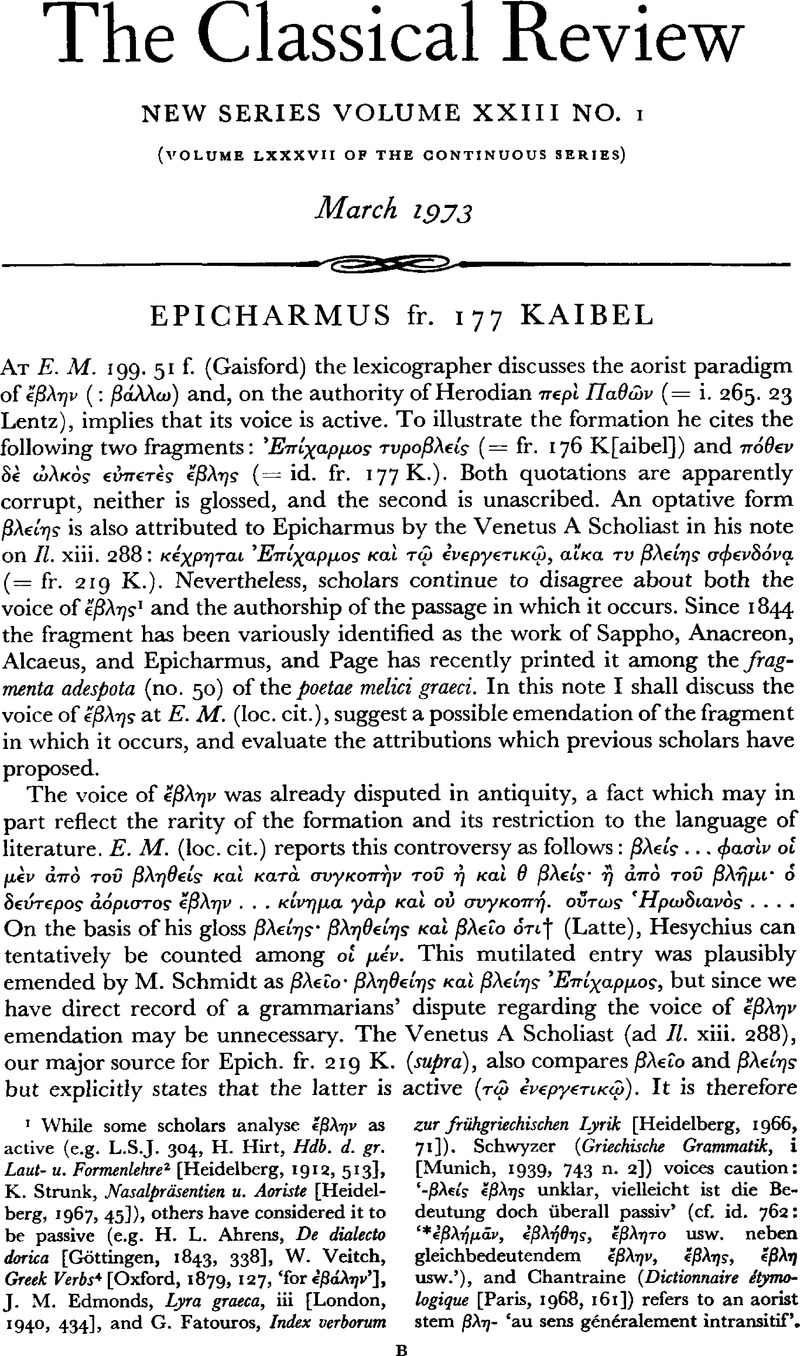Published online by Cambridge University Press: 27 February 2009

page 1 note 1 While some scholars analyse ξβλην as active (e.g. L.S.J. 304, H. Hirt, Hdb. d. gr. Laut- u. Formenlehre 2 [Heidelberg, 1912, 513], K. Strunk, Nasalpräsentien u. Aoriste [Heidel-berg, 1967, 45]), others have considered it to be passive (e.g. H. L. Ahrens, De dialecto dorica [Göttingen, 1843, 338], W. Veitch, Greek Verbs 4 [Oxford, 1879, 127, ‘for ⋯β⋯λην’] J. M. Edmonds, Lyra graeca, iii [London, 1940, 434], and G. Fatouros, Index verborum zur frühgriechischen Lyrik [Heidelberg, 1966, 71]). Schwyzer (Griechische Grammatik, i [Munich, 1939, 743 n. 2]) voices caution: ‘-βλε⋯ς ξβλης unklar, vielleicht ist die Bedeutung doch überall passiv’ (cf. id. 762: ‘*⋯βλ⋯μᾱν, ⋯βλ⋯θης, ἔβλητο usw. neben gleichbedeutendem ἔβλην, ἔβλης, ἔβλη usw.’), and Chantraine (Dictionnaire étymo-logique [Paris, 1968, 161]) refers to an aoriststem βλη- ‘au sens généralement intransitif’.
page 2 note 1 Cf. Berk, L., Epicharmus (Groningen, 1964, 35 f.;Google Scholar Berk does not himself discuss the three fragments in question).
page 2 note 2 Kaibel, G., Comicorum graecorum fragmenta (Berlin, 1899)Google Scholar, Olivieri, A., Frammenti della commedia greca e del mimo nella Suilia nella Magna Grecia, i (Naples, 1946).Google Scholar
page 2 note 3 Commentationum criticarum specimen (Mar-burg, 1844, 9, ‘temere’, according to E. Diehl, Anthologia lyrica graeca [Leipzig, 1954], ad mon. adesp. 21).
page 2 note 4 Beiträge zur Kritik der Poetae lyrici graeci (Göttingen, 1844, 124). for further details concerning the bitter controversy between Schneidewin and Bergk, see my article ‘On Pindar fr. 104 b (Snell)’ (to appear in C.Q.).
page 2 note 5 O. Hoffmann, Die griechischen Dialekte, ii (Göttingen, 1893, 198, adesp. 75: π⋯θεν δ⋯ τὦλκος [= τ⋯ ἔλκος, cf. Ahrens, supra] εὔπετες [ − ] ἔβλης), E. Diehl (loc. cit.), J. M. Edmonds (loc. cit., fr. 38, ‘anonymous: Sappho or Alcaeus (?)’).
page 3 note 1 ξυμβλ⋯την (Od. xxi. 15), pace L.S.J. 304, is best explained with Risch (Wordbildung der homerischen Sprache [Berlin–Leipzig, 1937, 207]) as a nonce-form based on the medio-passive stem ξυμβλη-, and not as a productive example of the paradigm of ἔβλην (cf. Hesychian ξ⋯μβλητε. συνετ⋯χετε). I discuss the formation of ξυμβλ⋯την more fully in a forthcoming article on the historical morphology of ἔβλην, in which I also argue that the Coan 3 sg. pass. subj. ⋯ποβλ⋯ι is an engraver's error for ⋯ποβληθ⋯ι. The present form βλ⋯μι seems to be merely a gramdermarians’ fiction dependent on ἔβλην.
page 3 note 2 Cf. Hj. Frisk, Griechisches etymologisches Wörterbuch, ii. 849.
page 3 note 3 Cf. Schulze, W., Quaestiones epicae (Gütersloh, 1892, 391 f.)Google Scholar, Bechtel, F., Die griechischen Dialekte, ii (Berlin, 1923, 212 f.)Google Scholar, and Berk (op. cit., 76 f. and passim).